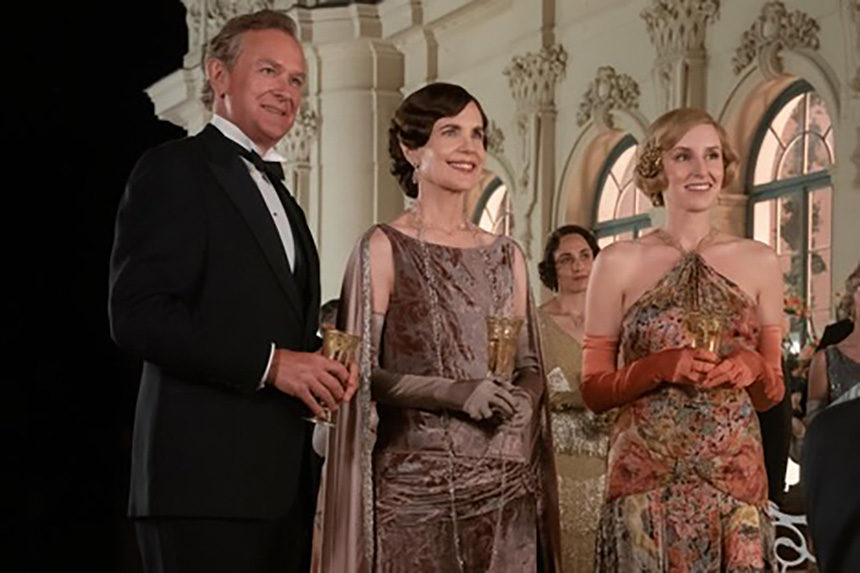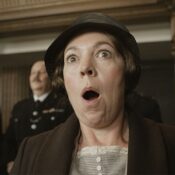Downton Abbey: A New Era
⭐️ ⭐️ ⭐️
Rating: PG
Run Time: 2 hours 4 minutes
Stars: Hugh Bonneville, Elizabeth McGovern, Maggie Smith, Michelle Dockery
Writer: Julian Fellowes
Director: Simon Curtis
Julian Fellowes is like that great uncle who always knew exactly what gift to give you — even as your parents stood in the background, tut-tutting and saying, “Really, you shouldn’t have…”
For those who never fell out of love with the creator/writer’s long-running TV series, Downton Abbey: A New Era is a gift-wrapped reason to return to the movie theater. Sumptuous, silly, and defiantly sentimental, it’s a feast of empty calories spoon-fed by a heavyweight cast.
In a crowded two hours, Fellowes parades nearly all his familiar characters across the screen, featuring some while allowing others little more than a cameo (my personal favorites, the lovely Mr. and Mrs. Bates — each of whom endured murder charges during the TV days — register barely a blip here).
Such neglect is, I guess, inevitable: By my count, both upstairs and downstairs, A New Era has roughly 20 “central” characters. Not since Robert Altman’s everybody-into-the-pool Nashville days has a film sent so many major faces jostling for position on screen.
While purportedly advancing the saga of the aristocratic Crawley Family and the eventful lives of the small army in their household employ, like Downton’s previous feature film spin-off, story is of secondary importance here. It’s the characters we’re obsessed with: with Mrs. Patmore’s flibbertigibbet squeals; with Daisy’s sweet-natured naiveté; with Barrow’s smoldering torment; with Edith’s yearning to shatter Britain’s sexist glass ceiling. Give us a story, sure — but also, just let us sit a spell with these characters who were so vividly drawn over six TV seasons.
The plot, such as it is, is two-pronged: While a movie company encamps in the Crawleys’ palatial home to make a feature film, most of the Crawleys head off to the South of France to check out an exquisite villa that has been unexpectedly left to Violet Crawley, the Dowager Countess of Grantham.
Yes, you read that right: Violet, played by Maggie Smith, is back. And, yes, at the end of the previous Downton Abbey film she was given a magnificent send-off after informing her granddaughter Mary (Michelle Dockery) she was soon going to die.
Yet, here Violet is again, still dying, yet peppery as ever, holding court in the parlor and hurling droll Violetisms that stick to their targets like clumps of warm figgy pudding.
As the two plots proceed in parallel fashion, director Simon Curtis rather inelegantly splices them together with little or no concern for continuity. But that matters little. Curtis’s sentiment-wringing bonafides were confirmed with films like Goodbye Christopher Robin and The Art of Racing in the Rain, and he knows exactly when to stop the wisp of a narrative for a perfectly timed tableaux of teary-eyed reflection — as when Violet and her old nemesis Isobel (Penelope Wilton) exchange murmurs of grudging affection.
Hugh Bonneville, who most Americans have no idea is one of Britain’s great comic actors, once more harrumphs his way through this extended episode, although his Lord Grantham is permitted one absolutely spot-on double-take when he gets some unexpected news about his possible genetic line. He also gets to react emotionally to some possibly bad news from his wife Cora, played by Elizabeth McGovern with that same “I’m-smiling-so-hard-my-face-hurts” quality that makes most longtime fans suspect Cora may someday emerge from the abbey covered in blood, laughing maniacally and holding the severed head of Lord Grantham by its hair.
Given the subtitle of the film and the diminishing importance (and/or departure) of the older characters, it is not unreasonable to suspect A New Era is signaling a future focused on the young’ns. Dockery’s Lady Mary is conspicuously without her car enthusiast husband Henry — she keeps moaning about how he’s off at a race somewhere — and even though fans know Matthew Goode couldn’t be in this film because he was making The Offer for Paramount+, it’s clear we’re being set up for Mary to be on the prowl again.
Likewise, there’s a lot of beefing up going on regarding Tom and Lucy Branson (Allen Leech and Tuppence Middleton). It seems that, in her own will, Violet has left that French villa to Tom’s young daughter. If Violet dies (again!), that could cause all kinds of palace intrigue among the denizens of Downton.
And so, just as in the old TV days, at the moment he’s tying up one loose end, Fellowes is unraveling another strand. It’s a formula that has worked in movie serials since the days of Buck Rogers — who, like Violet Crawley, also managed to survive more than one death scene.
Featured image: Scene from Downton Abbey: A New Era (Ben Blackall/Focus Features)
Become a Saturday Evening Post member and enjoy unlimited access. Subscribe now




Comments
FYI – In the first film, while Violet did tell Mary she was ill, she did not die. She felt she was coming to the end of her life. Get your story straight.
As an avid Downton fan, I thoroughly enjoyed the movie. I wouldn’t waste my money on 99.9% of the other movies made today.